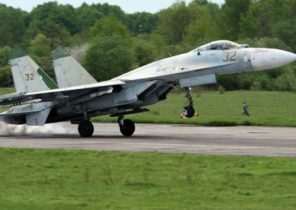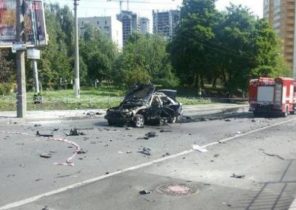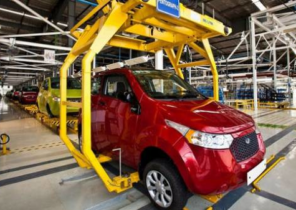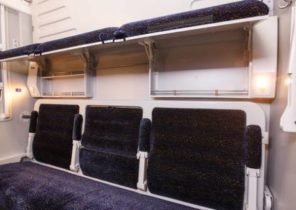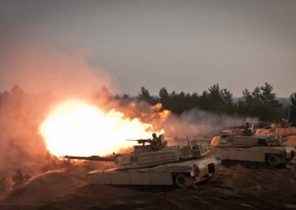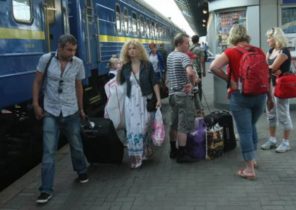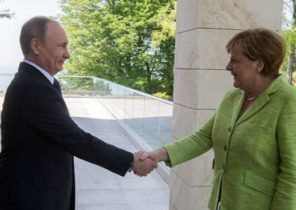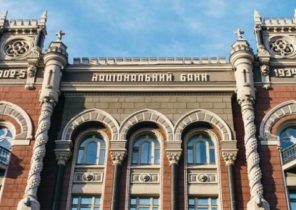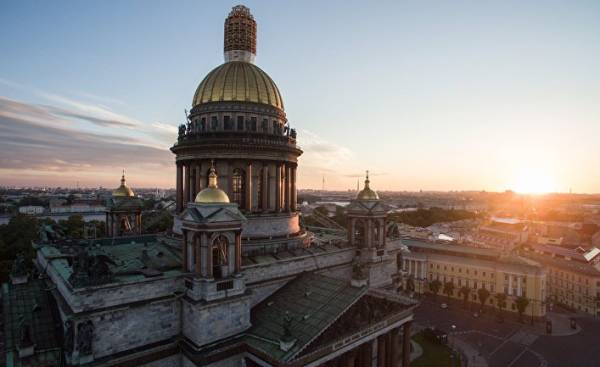
In 1985 I spent 13 days in Russia, which then was officially called the Union of Soviet Socialist Republics. However, for convenience I will call the country of Russia. The organization that trip worked the Smithsonian institution, and in our group there were about 100 people. After 32 years, during which occurred a great many radical changes, I again went to Russia, this time with three dozen comrades and capitalist under the auspices of the National Symphony orchestra. (I’m 22 years was on the Board of Directors of the orchestra, and third year working in the Board of Trustees. The fact that the Director usually from Washington, and the members of the Board of Trustees most often from other places. Therefore, he moved to Charleston, South Carolina, I moved from one Council to another.) And I saw a completely different Russia. In this article I will tell about my second visit to Russia. (Link to article about the first visit here).
My second trip to Russia took place from 24 March to 4 April. In a tragic coincidence, it coincided with two attacks — 22 March at Westminster bridge and 3 April at the metro in St. Petersburg. Arriving in the morning on March 23 in London, I went to the Sofitel London Heathrow is connected to the fifth terminal, and the whole day was watching the news about this terrible tragedy. The next day I flew to Moscow. Explosion in St.-Petersburg subway occurred two hours later, after I with his guide drove the same route (it’s part of the new Russia metro lines built in 2014). I had lunch and went to the hotel, and the staff there told me that I didn’t leave the hotel. I followed the advice of the local and refused evening hike to the nearest restaurant. Of course, not to say that I was on the verge of death, but the feeling was unpleasant. Discouraged, I again stared blankly at the TV screen, but this time TV watching was interrupted several times by their calls and emails concerned friends, both old and new (great guides). On 5 April I flew to the United States and then learned that the President, trump launched fifty odd cruise missiles at Syria, in order to understand the cruel leader of this country that America will not tolerate weapons of mass destruction. The town has a new Sheriff, and it angered someone, and Vladimir Putin. The people thought about the prospects of American tourism in Russia, at least for the near future. The Outlook is not very bright.
24 March, Moscow. In the afternoon I arrive in Domodedovo airport, one of three international Moscow airports. DME, as written on the baggage receipt, the largest in Russia. in 2000, he served 2.8 million passengers, and in 2015, the passenger traffic rose to 30 million. It is 42 kilometers South of Moscow. It is huge compared to the little Sheremetyevo airport, through which I was leaving Russia in 1985. In 1985 at Sheremetyevo sat down small aircraft, and both he and the Leningrad airport was dirty and neglected. Domodedovo airport is modern, clean and spacious, although it can hardly be called a model of airport aesthetics. At passport control takes more than an hour. In 1985, our plane was the only one in the airport, ready for departure, but now they are much more, so the queue is quite natural. If you look at the list of the 30 busiest airports in the world in 2015, we will see that the international airport Hartfield-Jackson in Atlanta is in first place because it took 101 million passengers. On 30-th place international airport George Bush Houston with 42 million passengers. So DME will not soon fall into this list. Moscow with a population of 16 million people is 15-th place in the list of most populous cities, while Atlanta, with its five million is on the 75th place. However, the rapid growth of Moscow is the deep impression. Due to traffic I was driving to my hotel an hour and a half, and the last two kilometers took at least 30 minutes. Some musicians from the National Symphony orchestra, arrived a couple of days later, I had to go to the hotel two and a half hours, so I was lucky. I checked in to the luxurious Four Seasons hotel Moscow located near red square. Good news: there was no duty on each floor, and externally his manners similar to prison guards. In 1985, these ladies took me the room key whenever I left, and gave back. That evening I had dinner in the main hotel restaurant is Quadrum, which offers a dazzling view of the evening Kremlin. The kitchen was great — Italian, international. I ate much better than in 1985, that’s for sure. I started with vodka (it’s Russian, American), then tried a classic cocktail Negroni, which has its own history, originating in 1919. Florentine count Camillo Negroni asked the bartender at the restaurant (the restaurant twice since then changed the name, but still works) to pour the cocktail Americano gin instead of soda. To a new cocktail different from its predecessor, the bartender had decorated the glass with slice of orange instead of lemon, thus underlining the significance of the new creation.
On 25 March, Moscow. In the sky the clouds, the sun, and I with my guide going to the city the Wedge (located 85 kilometers from Moscow) to see the last residence of the great composer Pyotr Tchaikovsky. The road is free, but it takes half an hour over the speed limit (60 kph). On Saturday little machines, but not only due to the fact that the output. Local residents try not to travel on the new road, which paid. The house itself is charming composer, there are a lot of the original furniture. In a separate building there is a concert hall, where also a lot of memorabilia. In his new book, “Moscow nights. Van Cliburn: as one man with his piano melted the ice of the cold war” (Moscow Nights: The Van Cliburn Story — How One Man and His Piano Transformed the Cold War) Nigel cliff (Nigel Cliff) tells the story of the first International Tchaikovsky competition in Moscow in 1958. He notes that the world fame came to the Cliburn after the execution of the First piano Concerto by Tchaikovsky. In honor of the victory in the competition, he arranged a solemn reception on Broadway and was awarded numerous honors and awards. Alas, a mega-triumph 1958 Cliburn could not repeat. But the author notes one fiction oddity. The first piano Concerto by Tchaikovsky performed by Cliburn was from the beginning, wildly popular in the States, but in Russia he has long enjoyed success. At the end of the tour there was one funny moment. I was led into a room with a CD player and was asked to choose and listen to favorite works of the composer. I chose the first part of the First piano Concerto by Tchaikovsky — but I was told that the Museum it is not! When we went back, my guide, Marianne told me that in my childhood my parents took her in 1958 for a competition, and she listened to Cliburn. It was one of the brightest moments in her life. Marianne still has a ticket. Because her father was a scientist and mother a musician, they had the right not only to a separate apartment, but in free tickets to various cultural events. She was delighted with the great Russian music, dance and theatre classics. Upon arrival in the city, I still had time, and I visited the space Museum in front of which is rising to the sky a monument. In the Museum there are materials on the accomplishments of American spaceflight. That evening I had dinner with friends who also came on the eve of the tour. We went to “Cafe Pushkin”, where he tried a phenomenal Russian cuisine in a chic setting. Because at that place are numerous street barriers and prohibited turns to the right, to the restaurant we went more than 20 minutes, and I went back less than 10.
On March 26, Moscow. In the hotel restaurant I tried the pancakes. They’re light as a feather, and quite similar to those that we usually eat in America. The weather is clear and Sunny and the tour guide takes me 70 kilometers from Moscow to the medieval monastery of the Trinity-Sergius Lavra. (The monastery is a Greek monastery.) I take pictures of rare beauty: a great number of domes of Orthodox churches, which are bathed in bright sunlight. After returning we have lunch in the restaurant Savva in the legendary, newly renovated hotel “Metropol”. Still we have time to visit the Museum-estate of Tolstoy. Then I drink tea with the guide who accompanied me in 2013, a railway journey on the silk road, through three of the five ‘Stans’. Wags refer to these countries collectively “Jennifer Aniston” in honor of the beloved actress. Tonight I’m having dinner with newly arrived friends from Charleston.
On 27 March, Moscow. Charlestons with whom I had dinner last night, coming with me to see the Moscow sights. But in Moscow it’s cold out, the sky is tightened gray clouds, and after a glorious weekend it starts to rain. This time of year the weather in Moscow is not so bad. When I flew from Washington, it was as cold as now in Moscow, about minus five degrees. We’re not complaining. Exactly 49 years ago van Cliburn played his first full day in Moscow, preparing for the competition, which made him famous all over the world, and the day before in Moscow was minus 23 degrees. Yes, and after his arrival, the temperature did not rise above zero. We visited Novodevichy monastery and cemetery, where rested a cavalcade of Russian and Soviet heroes. At first it was a fortress built in 1524, which in Imperial times had seen many battles. The nuns rescued her from the Napoleonic legions and the Soviets turned the monastery into a Museum, however, later re-opened Church of the assumption of the blessed virgin. In the graveyard, mostly prominent figures of the Soviet era, but there also is the tomb of Anton Chekhov. At the Novodevichy found the last resting place of two of the head of state (Nikita Khrushchev and Boris Yeltsin), two of the famous composer and was awarded the Stalin prizes (Sergei Prokofiev and Dmitri Shostakovich), and a former musician of the National Symphony orchestra Mstislav Rostropovich, who in the mid-1970s, was allowed to emigrate and join his fellow dissident Alexander Solzhenitsyn. For me, the major figure was Khrushchev who led the Soviet Union from 1957 to 1964. When the Soviets launched Sputnik, when it was the Cuban missile crisis, and he went twice to visit in the United States. In 1959, he has not visited in Manhattan, where at the time I grew up. During his visit, he visited Disneyland and dined with the aristocracy of Hollywood. Khrushchev planted next to Marilyn Monroe, and his wife, Nina Khrushchev sat next to Bob Hope and Frank Sinatra. Nina was fascinated by their neighbours in the table, and to Nikita Khrushchev, Marilyn did not like. If she found attractive Khrushchev, who was hardly like her husband Joe Di Maggio? Marilyn confidently said no (Oh, Marilyn, you have lived in Russia, no freedom of choice you wouldn’t have.) Manhattan Khrushchev visited in September 1960, where he pounded his Shoe on the podium of the General Assembly (thereby causing the debate, typical for GA). But the generation of baby boomers remember Khrushchev on the song from the Comedy about police “Patrol car 54”. As for Rostropovich, Slava, as everybody called him, 17 seasons worked as conductor of the National Symphony orchestra (1977-1994). It was a charming man and consummate cellist. Working as musical Director (conductor) of the orchestra, he took half of its composition, greatly increasing the level of performances. We visited several famous stations of the Moscow metro, including the “Mayakovsky”, located near our hotel (I may have seen them in 1985). In the evening we had dinner with a group of friends of the National Symphony orchestra (35 people, mainly the Trustees) in the Asian restaurant “Turandot”. This fine establishment, located near “Cafe Pushkin”. On the ground floor there is a white Grand piano. When we walked in, the song sounded As Time Goes By from the movie Casablanca. I raised my glass of vodka to drink for actors Rick, Sam, ILSA and the painting.
March 28, Moscow. In the morning the weather was the most disgusting in all of my trips. It was the cold rain, rainy stormy, veriwave umbrellas from the hands of passers-by. And we wandered around the Kremlin. The Marquis de Custine wrote the book “Russia in 1839”, which was compared with the “Democracy in America” Alexis de Tocqueville. There the Marquis called the Kremlin’s “satanic monument” and “a place that could benefit from some of the characters from the Apocalypse”. Custine wrote: “Like the skeletons of giant prehistoric animals, the Kremlin proves to us that the world, the reality of which we still continue to doubt, even finding his remains still exist.” Our visit, thank God, was much calmer and beznadejnoe. We visited the brilliant the Armory, saw the interior of the assumption Cathedral of the Russian Orthodox Church, and in the Diamond Fund stared at the Orlov diamond of 190 carats, presented to Catherine the great (ruled 1762-1796), her most famous lover count Orlov. We walked through red square, and then headed to the modern Bolshoi restaurant to enjoy elegant cuisine. After lunch we had a backstage tour of the famous Bolshoi theatre. We watched the rehearsing dancers, walked through the elegant rooms on the upper floors. I told our guide that in 1914, my aunt Helen, which at that time was eight years old, saw the legendary prima ballerina Anna Pavlova, who danced in new York. She smiled. In the evening we tasted the food at Spaso house, as it is called elegant residence of the American Ambassador. Before that, we listened to a beautiful duet of musicians, pianist Lisa Emenheiser and violist Daniel foster. Dan played a wonderful violin part of “Vocalise” by Rachmaninoff — performed like he plays it for many years, although in fact it was the first performance. I met the daughter of Fame Olga Rostropovich said that she is as lovely as her late mother, Opera singer Galina Vishnevskaya, and the same charming as her parents. The national Symphony orchestra became the first American team invited to participate in the International Rostropovich festival, which was established in 2009. It is appropriate to again remember van Cliburn. In 1958, the young star cellist Slava and his wife Galina invited him to dinner. Wang accepted the invitation. They talked about Opera and piano (Glory also played on it). Glory told Wang the famous aphorism of Chopin, the piano is not ten fingers, and ten great voices.
On 29 March, Moscow. The morning began with my second visit to the Tretyakov gallery. From my first visit 32 years have passed, but it’s still a real treasure. Then a late lunch at the restaurant “Zhivago”, located in the renovated and modernized the hotel “national”. (I lived there in 1985.) I got great pleasure from the magnificent chicken Kiev. Work there are delightful waitress, did not like the prison guards. But the main dish was an evening concert. It took place in the famous Moscow Conservatory with its perfect acoustics and sound. Cellist of our orchestra Alice Weilerstein performed a devilishly difficult Shostakovich Concerto No. 1 for cello. Alice, who once played with Glory, was encored. The hall was delighted. The Russian audience prefers rhythmic applause, the cacophony of applause, shouting “Bravo”. The evening concludes with a sophisticated reception in the Conservatory.
March 30, Moscow/Saint-Petersburg. We leave Moscow by high-speed train “Sapsan”, which covers 635 miles to St. Petersburg in three and a half hours, making only two stops. The train can accelerate to 250 kilometers per hour. It goes smoothly, the service on the train is good. The website of the train reported that today the service is completely missing the brutality of the Soviet era that its leaders in a modern friendly and courteous. (I think, today, the Soviet service can be seen on the United aircraft, whose flight attendants are not friendly.) During the trip, I kill time, considering the snow-covered landscape. But the cracks on the outside of the glass suggests that it once got something (I hope it’s not the kids throwing rocks). Arriving in St. Petersburg, we drive along the Nevsky prospect, where today is full of vehicles and pedestrians, as well as luxury shops. The sun is shining, which is very unusual for Peter. Settling in St. Petersburg Four Seasons hotel, I took advantage of the nice weather and went for a walk to photograph the building of the Admiralty. I can shoot in bright brilliant sunshine the steeple of the Admiralty. Then we visit the legendary Hermitage Museum, and after its closure. What a pleasure to see the paintings of Rembrandt, when there are not teeming with crowds of tourists. We’re having dinner at the marble Palace. Cunning I beg the opportunity to perform for our group As Time Goes By, Stardust and classical Russian romance “black Eyes”. Local musicians treated us folk music.
March 31, St. Petersburg / Pushkin. Another Sunny day — with the weather we’re lucky. Catherine Palace in Tsarskoye Selo, where I visited for the first time in 1985, when there was large-scale reconstruction, now mostly repaired. We look amazing Amber room, and then we show its restoration workshop. Then a late lunch at the American Consulate. I talk to Petersburgers about how much Russia has changed in 32 years. In the evening the national Symphony orchestra gives a farewell concert in dazzling white the Philharmonic hall, whose acoustics not inferior to the Moscow Conservatory. This evening sounds Shostakovich’s Eighth Symphony, and then the orchestra plays the “Sad waltz” the great Finnish composer Jean Sibelius.
April 1, Saint Petersburg. This is the last day we’re all together. Weather cloudy, and we go on an excursion to the spectacular Peter and Paul fortress built in the 18th century. In tsarist times it was a prison, and there sat a well-known opposition leaders. It is located on an island in the Neva river, and inside it is brilliant Peter and Paul Cathedral. Then we visit the Church with the gloomy name of the Church of Savior on Blood. On this very spot in 1881, the anarchists staged an ambush “Tsar liberator” Alexander II (who freed the serfs). As they say, no good deed goes unpunished. We have lunch in the restaurant “Mansarda” on the roof, and there we as a April fool offer dessert “Stone and sand”. In fact, this is the usual ice cream. After lunch we go to the magnificent St Isaac’s Cathedral. Our six-day stay in Russia, we end with a trip to the Yusupov Palace and a delicious dinner. This Palace is named after the Prince who led the conspiracy to assassinate the “mad monk” Grigory Rasputin. This old man literally falls under the spell of the last Empress Alix. She passionately believed that only Rasputin was able to cure the hemophilia of Tsarevich Alexei, who was the sole heir to the Romanov dynasty male. (Disorderly marriages between blood relatives has taken a heavy toll on European Royal families.) We were shown to a small but delightful performance of a pianist and two Opera singers from the famous Mariinsky theatre. We had dinner in the Palace, while a local pianist played what can be called a cocktail of classical music. They were mostly waltzes of Chopin, which obviously improve the appetite. In the end I suggested to my companions the final chord on the beautiful white Grand piano under the name “Red October” (no more, no less). I played “Moonlight” Debussy.
April 2, St. Petersburg. Tour of our National Symphony orchestra comes to an end. I stand alone and visit the museums of Dostoevsky, Rimsky-Korsakov and Pushkin. The guide at the Museum of Dostoevsky tells me that 16-year-olds in Russia, read a classic work of the writer of “Crime and punishment”. I ask whether it concerns only students of elite schools, and they say that it is a required work for all students. To me, it makes a great impression. I wonder if they can read “Crime and punishment” at least high school students from the American preference for private schools. In the Rimsky-Korsakov Museum tour guide let me play on the piano that was once played by the composer. I was not practicing his music (although she is gorgeous), except for “Song of the Indian guest”. But it was half a century ago, and I’ve forgotten all about it. So I performed the Prelude in C sharp minor by Rachmaninoff, which, to my delight, is very well regarded by the Museum staff. This was my final chord of musical diplomacy during the trip. This prelude was a favorite solo number of the public in the performance of the composer. Critics called her “Bells of Moscow”, because in this town at that time, there were 1,600 churches (composers rarely give names to their works). Rachmaninoff hated his prelude, because she wanted to listen to everything. That night I looked in the venerable Mariinsky theatre classical ballet of the late 19th century “La Bayadere”. Got a huge visual and musical pleasure.
April 3, Saint Petersburg. I went to exquisite Faberge Museum. Carl fabergé made about 50 eggs for the last Russian Tsar Nicholas II Romanov and his family. 11 was done for other customers. I then, with your guide, Julia took the subway. I visited the old station of St. Petersburg metro, built in 1955 (the first station opened in Moscow in 1935). Your journey I completed at the Museum of Russian vodka where and had lunch after the tour at the restaurant. Five shots got me through the terrible news about the terrorist attack, which I learned back at the hotel. There is even vodka “Kalashnikov”, which is sold in a bottle designed as the famous AK-47. It is not good. This family needs to make weapons. In my opinion (or rather, taste) the best of the vodkas that I’ve tried, this Beluga Gold.
April 4, St. Petersburg / Pavlovsk. Pack up and going to Pavlovsk together with fellow traveler of the National Symphony orchestra, who also decided to stay in St. Petersburg. There we have lunch in a rural restaurant “Podvorie”, a favorite spot of President Vladimir Putin. It is a treasure. We enjoy the Russian cuisine, ordering the five-course set menu from chef. It is 30 minutes drive from the stylish and modern Pulkovo airport. My second visit to Russia is complete.
Russia 2017. Observation. The hotel room was gorgeous, the amenities (especially the bathrooms) much better than before. People willingly go on contact, all smiles, lots of laughter. If there was a shortage of smiles, it is quite understandable, and explanations were given our charming tour guide Peter Catherine. The reason is language. Russian consonants are pronounced mostly with pursed lips, and consonants in English often pronounced with spread lips. But Catherine was smiling more than I am. However, it’s understandable: she’s cute and a lot more charming. In a country with a love of restoring historical sites and monuments, the renovation is a huge variety. There protect great classical art. The Russian audience is sophisticated and disciplined. After Shostakovich’s symphonies at the final concert conductor Christoph Eschenbach 20 seconds did not give up, and another 10 seconds it took him to lower them and give the audience the signal that the show is over. People were silent, absorbing the music that you just heard. In the hall was heard no rustling. Hardly the American public is capable of. Overall, despite our geopolitical differences, many Russians today are much better off than in 1985. Of course, the main part of Russia during that time has changed by less than two of its biggest city. But the process of modernization of the vast country, which has 11 time zones, which has experienced 75 years of Bolshevik tyranny, is not a task for one generation. And started Russian impressive.
Russia 2017. Conclusion CLEBURNE and National Symphony orchestra. During the final vote in 15 of the 17 members of the jury voted for the van, including the celebrated Russian pianists Sviatoslav Richter and Emil Gilels. It seemed that the victory Cliburn provided. But the jury knew that the powers hope to win Russian musician in this new prestigious competition. Therefore the jury decided to consult with the Ministry of culture. And it shifted the responsibility from himself to the Khrushchev. Culture Minister reported to Nikita Khrushchev that the problem with American pianist who “plays very well”. Khrushchev asked: “And what about him telling the others? He’s the best?” The Minister said: “He’s the best”. Then Khrushchev said, “In this case, give him the Grand prize.” At 11 PM, Wang called back to the concert hall to a select audience to record two of his latest: Rachmaninoff concert for piano and orchestra No. 3 in d minor and Tchaikovsky’s First piano Concerto. The recording of the Rachmaninoff concert lasted four hours, and record the Tchaikovsky Concerto was finished at dawn.
I think musicians from the National Symphony orchestra know that he felt in 1958 van Cliburn, when he said to the Russian public:
I went where I went, Tchaikovsky, Rachmaninoff, Skryabin and other great musicians. I touched extended to me a hearty reception. It’s a great pleasure to play for the Russian, who are such delicate music. The friendliness of the audience inspired me, and I had the feeling I was playing better than usual…. I’m happy to be in the homeland of the great Russian composers, whose work I deeply respect.
I think the same can be said about old and new friends of the National Symphony orchestra, who were lucky enough to accompany him in the triumphal tour in honor of its fourth music Director. Glory was the personification of consummate musical skill, and abiding love of family, friends and all humanity. The great music he left us, and the American orchestra, which he transformed, continue to bring classical music tradition of the West at the highest artistic level.
John Wohlstetter — senior researcher of the organization Discovery Institute and London Center for policy research, author of “Sleepwalking With the Bomb” and Creator of the blog Letter From the Capitol.
